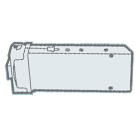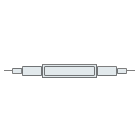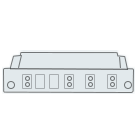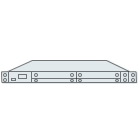Fiber Optic Tech
The Key Roles of Fiber Bypass Modules
Introduction
In the ever-evolving landscape of optical communications, ensuring network reliability, flexibility, and efficiency is paramount. Fiber bypass modules have emerged as critical components in telecom and data center networks, enabling seamless management of optical signals. These devices allow network operators to bypass specific equipment or nodes without disrupting signal transmission, maintaining uptime and optimizing performance. This article explores the common applications of fiber bypass modules, their technical advantages, and their significance in modern network architectures.
What Are Fiber Bypass Modules?
Fiber bypass modules, also known as optical bypass switches or modules, are specialized devices designed to redirect optical signals around a particular node or piece of equipment in a fiber optic network. They are typically used to maintain signal continuity in scenarios such as equipment failure, maintenance, or power outages. By rerouting optical signals, these modules prevent network downtime and ensure uninterrupted data transmission.
These modules operate at the physical layer of the network, interacting directly with optical signals without converting them to electrical signals. They are often integrated with optical switches or multiplexers and can be deployed in various configurations, such as 1x1, 1x2, or 2x2, depending on the network's requirements. Fiber bypass modules are essential in high-availability environments where even minimal downtime can result in significant operational or financial consequences.
Common Applications of Fiber Bypass Modules
Fiber bypass modules are widely used across telecom and data center networks due to their versatility and reliability. Below, we explore the key scenarios where these modules play a critical role.
1. Network Maintenance and Upgrades
One of the primary use cases for fiber bypass modules is during network maintenance or equipment upgrades. In telecom and data center environments, routine maintenance, software s, or hardware replacements are inevitable. Shutting down a node or device for maintenance could disrupt data transmission, leading to service outages. Fiber bypass modules address this challenge by redirecting optical signals around the affected equipment, ensuring continuous operation.
For example, in a Dense Wavelength Division Multiplexing (DWDM) system, a bypass module can reroute specific wavelengths around a malfunctioning amplifier or transponder. This capability allows technicians to service or replace equipment without impacting the overall network performance. In data centers, bypass modules are often integrated into optical distribution frames (ODFs) to facilitate seamless upgrades of optical transceivers or switches.
2. High-Availability Network Architectures
High-availability networks, such as those used in financial institutions, cloud service providers, and telecom carriers, demand near-zero downtime. Fiber bypass modules are critical in these environments, as they provide a failover mechanism to maintain network connectivity in the event of equipment failure. For instance, if a router or optical line system fails, the bypass module can automatically redirect traffic to a redundant path, minimizing service disruption.
In redundant ring topologies commonly used in metro or long-haul telecom networks, bypass modules ensure that optical signals can bypass a failed node while maintaining the integrity of the ring. This is particularly important in mission-critical applications where even a few seconds of downtime can lead to significant data loss or service degradation.
3. Disaster Recovery and Redundancy
Data centers and telecom networks often implement disaster recovery strategies to mitigate the impact of catastrophic events, such as power outages or natural disasters. Fiber bypass modules are integral to these strategies, as they enable rapid reconfiguration of optical paths to alternate routes or backup systems. By incorporating bypass modules into the network design, operators can ensure that critical services remain operational during unexpected events.
For example, in a data center with geographically distributed facilities, bypass modules can redirect traffic to a secondary site if the primary site experiences a failure. This capability is particularly valuable in cloud computing environments, where uninterrupted access to data and applications is a key requirement.
4. Testing and Monitoring
Fiber bypass modules are also used in network testing and monitoring applications. During the deployment or troubleshooting of optical networks, engineers may need to test equipment, such as optical time-domain reflectometers (OTDRs) or spectrum analyzers, into the signal path. Bypass modules allow test equipment to be connected without disrupting live traffic, enabling real-time analysis of network performance.
In data centers, bypass modules are often used in conjunction with network taps or monitoring systems to capture and analyze optical signals. This setup allows operators to monitor network health, detect anomalies, and optimize performance without affecting the primary data path.
5. Protection in ROADM-Based Networks
Reconfigurable Optical Add-Drop Multiplexers (ROADMs) are widely used in modern telecom networks to dynamically manage wavelength routing. Fiber bypass modules complement ROADM systems by providing protection against node failures or signal degradation. In a ROADM-based network, a bypass module can reroute specific wavelengths around a faulty node, ensuring that the network remains operational.
This application is particularly relevant in long-haul and metro networks, where ROADMs are used to manage high-capacity wavelength services. By integrating bypass modules, operators can enhance the resilience of ROADM-based architectures and reduce the risk of service disruptions.

Technical Advantages of Fiber Bypass Modules
Fiber bypass modules offer several technical advantages that make them indispensable in telecom and data center environments:
· Low Insertion Loss: Bypass modules are designed to minimize signal attenuation, ensuring that optical signals maintain their strength and quality during rerouting.
· High Reliability: These modules are built to operate in demanding environments, with robust designs that ensure long-term performance and minimal maintenance.
· Protocol and Bit-Rate Independence: Since bypass modules operate at the physical layer, they are agnostic to the data protocol or bit rate, making them compatible with a wide range of network configurations.
· Fast Switching Times: In failover scenarios, bypass modules can redirect signals in milliseconds, minimizing the impact of equipment failures.
· Scalability: Bypass modules can be easily integrated into existing network infrastructures, supporting scalability as traffic demands grow.
Considerations for Deployment
While fiber bypass modules offer significant benefits, their deployment requires careful planning to ensure optimal performance. Key considerations include:
· Network Topology: The choice of bypass module configuration (e.g., 1x1, 1x2, or 2x2) depends on the network topology and redundancy requirements. Operators must assess whether a single bypass or multiple bypass paths are needed.
· Compatibility: Bypass modules must be compatible with the optical components in the network, including transceivers, amplifiers, and multiplexers. This includes matching wavelength ranges and connector types.
· Control Mechanisms: Bypass modules can be controlled manually or automatically through network management systems. Automated control is preferred in high-availability environments to enable rapid failover.
· Power Requirements: In some cases, bypass modules require external power to operate the optical switch. Operators must ensure that power redundancy is in place to avoid single points of failure.
Future Trends in Fiber Bypass Technology
As optical networks continue to evolve, fiber bypass modules are expected to play an increasingly important role. Emerging trends in the industry include:
· Integration with SDN: Software-Defined Networking (SDN) enables dynamic control of optical networks. Future bypass modules are likely to be tightly integrated with SDN controllers, allowing for real-time reconfiguration of optical paths based on network conditions.
· Higher Capacity Systems: With the rise of 400G and 800G optical systems, bypass modules will need to support higher data rates and denser wavelength configurations.
· AI-Driven Network Management: Artificial intelligence (AI) and machine learning (ML) are being used to predict and prevent network failures. Bypass modules could be integrated with AI-driven systems to proactively reroute traffic before issues occur.
· Compact and Modular Designs: Advances in photonics are leading to smaller, more modular bypass modules that can be easily deployed in space-constrained environments, such as edge data centers.
Conclusion
Fiber bypass modules are a cornerstone of modern telecom and data center networks, providing the flexibility and reliability needed to maintain uninterrupted connectivity. From enabling seamless maintenance to supporting disaster recovery and high-availability architectures, these modules address a wide range of operational challenges. As optical networks continue to scale and evolve, the role of bypass modules will only grow in importance, driven by advancements in technology and the increasing demand for robust, high-performance networks.
By understanding the applications and benefits of fiber bypass modules, network operators can make informed decisions to enhance their infrastructure's resilience and efficiency. Whether in telecom backbones or hyperscale data centers, these devices are key to ensuring that optical networks remain reliable and future-proof.



















